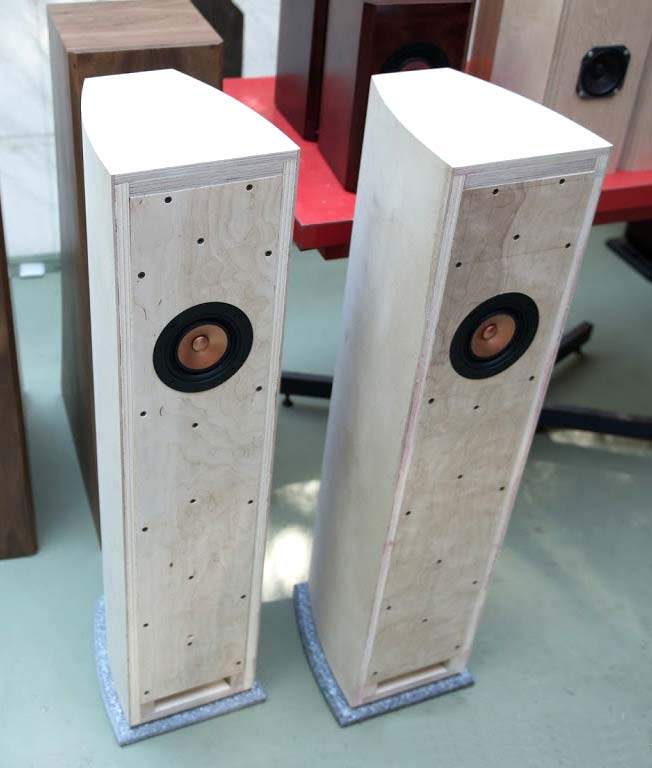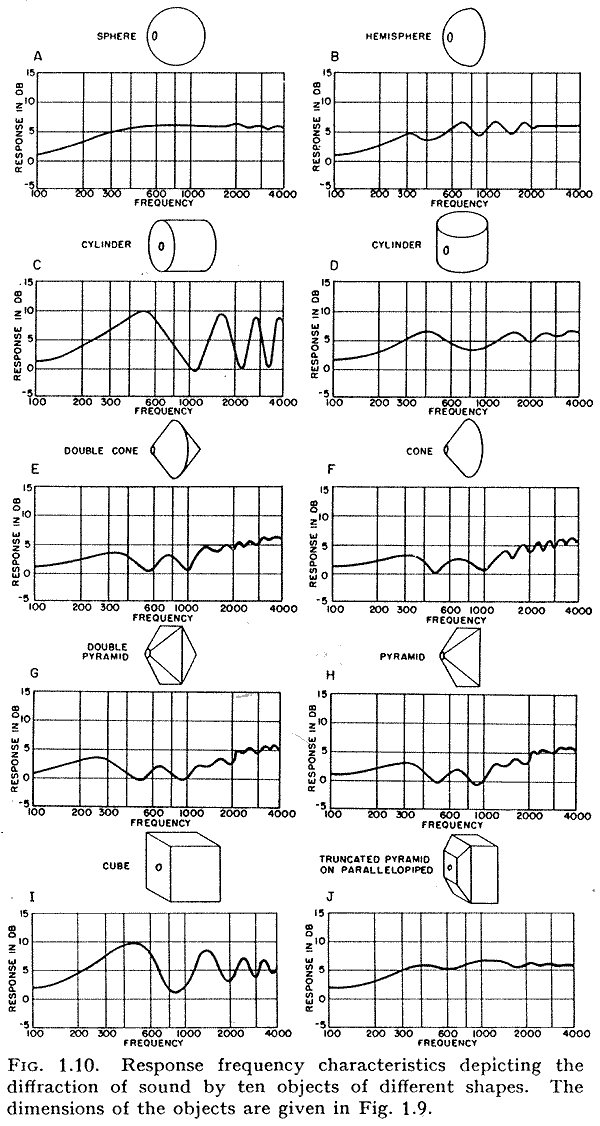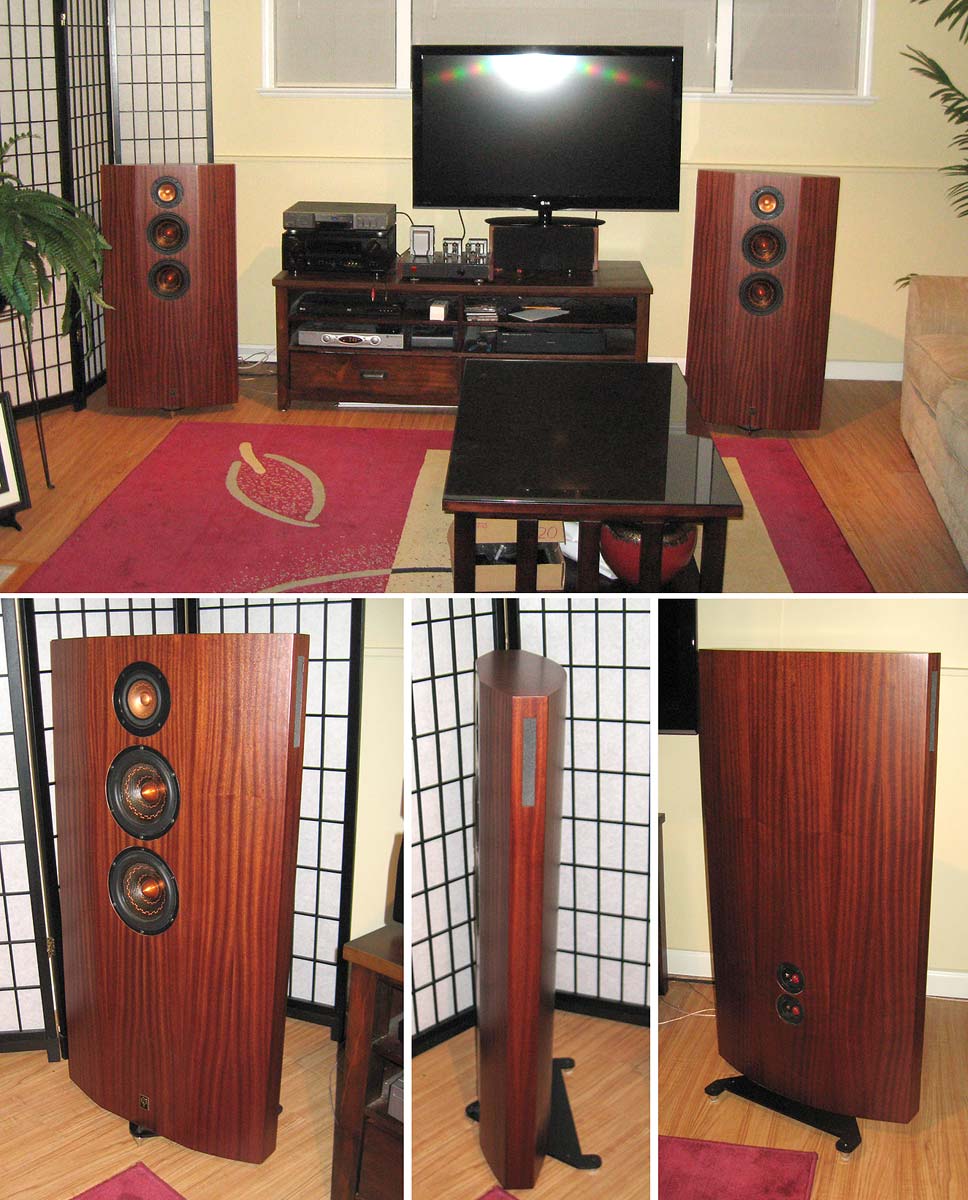Hello DIYers,
Hope you can help. I’ll make it short. I have the 10p in a Pensil and a 12p in a 19L Base Reflex which does not impress me much. I love the Pensils, bass is enough for what I listen to. I would like to find a better (imaging, detail, finesse, soundstage) enclosure for both. No SuperPensil 12p or FHXL since space will not allow it but would like a floorstand(10p or 12p) and a standmount(10p or 12p). I was thinking of the Mar-ken with side vents (Dave's design) standmounts or MA 12p in a Juliet or CGR Mar-Ken 12p. and the Mar-ken 10p floorstand.
What would the Mar-ken with side vents (Dave's design) standmounts bring over the Pensil? Would the Mar-ken with side vents bring enough bass to the table? What do you think would be the better box for the 12p?
BTW The speakers will be fed with a Finale 6watt EL84 tube amp.
Thanks
Hope you can help. I’ll make it short. I have the 10p in a Pensil and a 12p in a 19L Base Reflex which does not impress me much. I love the Pensils, bass is enough for what I listen to. I would like to find a better (imaging, detail, finesse, soundstage) enclosure for both. No SuperPensil 12p or FHXL since space will not allow it but would like a floorstand(10p or 12p) and a standmount(10p or 12p). I was thinking of the Mar-ken with side vents (Dave's design) standmounts or MA 12p in a Juliet or CGR Mar-Ken 12p. and the Mar-ken 10p floorstand.
What would the Mar-ken with side vents (Dave's design) standmounts bring over the Pensil? Would the Mar-ken with side vents bring enough bass to the table? What do you think would be the better box for the 12p?
BTW The speakers will be fed with a Finale 6watt EL84 tube amp.
Thanks
Unless that amplifier has a relatively high output impedance a 19 litre vented box is unlikely to have a particularly good LF alignment with the 12P, which is a relatively low Q unit designed primarily for use with amplifiers of that kind, and in general, requires a horn or QW variation for best results if LF output is the objective.
'Imaging', 'detail', 'finesse' and 'soundstage' have no technical meaning, and therefore no single causal factor. However, reduced diffraction signature and room positioning will place a role in the 1st, 3rd & 4th, speaking in broad conceptual terms. Unfortunately, that also falls somewhat by the wayside with wideband drive units, which are increasingly directional as frequency rises, and thereby somewhat less affected by baffle form factors due to their narrowing polars with frequency than drivers with a broader midband & HF dispersion.
For the 2nd, this is ultimately connected to the driver's frequency & harmonic distortion responses. Dave's resistively vented cabinets do not produce as much bass gain (output) as a regular vented enclosure, QW, horn etc. because that isn't their objective. They are designed to use the high vent aspect ratio to damp the alignment & provide a less reactive load for the amplifier, which may in turn reduce distortion as it doesn't need to rapidly slew current in the LF.
'Imaging', 'detail', 'finesse' and 'soundstage' have no technical meaning, and therefore no single causal factor. However, reduced diffraction signature and room positioning will place a role in the 1st, 3rd & 4th, speaking in broad conceptual terms. Unfortunately, that also falls somewhat by the wayside with wideband drive units, which are increasingly directional as frequency rises, and thereby somewhat less affected by baffle form factors due to their narrowing polars with frequency than drivers with a broader midband & HF dispersion.
For the 2nd, this is ultimately connected to the driver's frequency & harmonic distortion responses. Dave's resistively vented cabinets do not produce as much bass gain (output) as a regular vented enclosure, QW, horn etc. because that isn't their objective. They are designed to use the high vent aspect ratio to damp the alignment & provide a less reactive load for the amplifier, which may in turn reduce distortion as it doesn't need to rapidly slew current in the LF.
It is the shape of the trapezoid, and the (effictively) non-resonate walls make for an enclosure with a very low diffraction signature. They only go as low as they go. But what they do they do will elegance. Add a driver that does not draw attention to itself and has good DDR. EnABLed they get better.
You could think about tarting up the case of a pensil to minimize its diffraction signature.
What comes before has to feed the loudspeaker the information required to form the illusion of a 3D image/soundstage.
dave
You could think about tarting up the case of a pensil to minimize its diffraction signature.
What comes before has to feed the loudspeaker the information required to form the illusion of a 3D image/soundstage.
dave
Last edited:
Hey!
Seems like I got it with a little bass reflex to A12.2P.
17 liters and a tube that is diam 35mm and 40mm long. I have placed the tube on the back a little below A12.2P. I dont use damping matrial right now.
The base is ok and goes deep enough.
If you place the speakers closer to the wall ~ (0.5m), the energy in the base increases. I prefer 1m out of the wall.
The speakers stand 1.70m apart and I sit ~ 2.30m in front of them.
They are not turned inwards. There will be good balance then and I hear sounds outside the speakers. Of course, it depends on what kind of electronics you have and what disc is being played.
My speakers are on a standmounts. A12.2P is slightly higher placed than my ears. But it works great anyway.
The disc with Roger Water's "Amused to death" I often listen to when I tune in the speakers. The disc is recorded in Qsound. The sound moves around the whole room.
Recommended.
Regards
Leif
Seems like I got it with a little bass reflex to A12.2P.
17 liters and a tube that is diam 35mm and 40mm long. I have placed the tube on the back a little below A12.2P. I dont use damping matrial right now.
The base is ok and goes deep enough.
If you place the speakers closer to the wall ~ (0.5m), the energy in the base increases. I prefer 1m out of the wall.
The speakers stand 1.70m apart and I sit ~ 2.30m in front of them.
They are not turned inwards. There will be good balance then and I hear sounds outside the speakers. Of course, it depends on what kind of electronics you have and what disc is being played.
My speakers are on a standmounts. A12.2P is slightly higher placed than my ears. But it works great anyway.
The disc with Roger Water's "Amused to death" I often listen to when I tune in the speakers. The disc is recorded in Qsound. The sound moves around the whole room.
Recommended.
Regards
Leif
Last edited:
I can admit that it sounds a bit fuzzy without damping material. Decided I should add some damping. .
Out with the driver. In with damping material.
The back wall and side walls were covered.
In with the driver again.
I usually use a screwdriver to screw in the screws 80%.
Then I tighten all the screws 100%. Then I loosen 1/4 turn.
Then put the speakers in place. Inserting a CD. "Keith dont go" with Nils Lofgren.
Wow already the first notes you hear how detailed it sounds.
All the micro details spread throughout the soundscape.
Nils guitar sounds tuned.
It is located exactly in the middle. The fuzzy is gone.
His voice is so beautiful.
Think what a little damping material can make a difference. The whole sound picture changes.
All is better.
Regards
Leif
Out with the driver. In with damping material.
The back wall and side walls were covered.
In with the driver again.
I usually use a screwdriver to screw in the screws 80%.
Then I tighten all the screws 100%. Then I loosen 1/4 turn.
Then put the speakers in place. Inserting a CD. "Keith dont go" with Nils Lofgren.
Wow already the first notes you hear how detailed it sounds.
All the micro details spread throughout the soundscape.
Nils guitar sounds tuned.
It is located exactly in the middle. The fuzzy is gone.
His voice is so beautiful.
Think what a little damping material can make a difference. The whole sound picture changes.
All is better.
Regards
Leif
Dave,
Not sure what you mean by this:
"You could think about trarting up the dpse of a pensil to minimize its diffraction signature"
I love the 10p in the pensils. Would be great if I could make them better then I would only need to find a good standmount design for the 12p.
All Pensil 10p tweaks are welcomed BTW.
Has anybody heard the 12p in Dave's Mar-ken standmount design with the side vents?
Not sure what you mean by this:
"You could think about trarting up the dpse of a pensil to minimize its diffraction signature"
I love the 10p in the pensils. Would be great if I could make them better then I would only need to find a good standmount design for the 12p.
All Pensil 10p tweaks are welcomed BTW.
Has anybody heard the 12p in Dave's Mar-ken standmount design with the side vents?
Boy am i a bad typer. You could think about tarting up the case of a pensil to minimize its diffraction signature."You could think about trarting up the dpse of a pensil to minimize its diffraction signature"
Make a pansil but in a shape that decreases diffraction effects. Both at high frequncies and the transition form 2π to 4“.
dave
There is no magic. Building low diffraction enclosures definitly takes more effort.
dave
dave
Last edited:
When the baffle is small, the speaker is easier to disappear in the sound image. If you can phase the baffle with a phase (45 °), this has a positive effect on a smoother frequency response.
A sphere, globe is the very best shape. Such a form has the least effect.
Unfortunately, it is difficult to manufacture.
A phased (45 °) baffle is the next best. It does not differ much compared to a globe.
When you make the speakers disappear in the sound image, it opens doors that you did not know existed.
It becomes more fun to listen when your old records get a whole new content.
Micro-details emerge more clearly and the placement of musicians and singers more accurately.
It is a whole science to create the best conditions for a perfect reproduction of a recording.
Regards
Leif
A sphere, globe is the very best shape. Such a form has the least effect.
Unfortunately, it is difficult to manufacture.
A phased (45 °) baffle is the next best. It does not differ much compared to a globe.
When you make the speakers disappear in the sound image, it opens doors that you did not know existed.
It becomes more fun to listen when your old records get a whole new content.
Micro-details emerge more clearly and the placement of musicians and singers more accurately.
It is a whole science to create the best conditions for a perfect reproduction of a recording.
Regards
Leif
Historically to me, 6watt EL84 = 5.7 W 6BQ5 Class A = M.I., small radio/console amp = matching impedance, but couldn't find any info on the Finale, so would be nice to know for future reference.Unless that amplifier has a relatively high output impedance
Step 1 would add BIG bevels or big roundovers on the edges.
Or cover the baffle with open cell foam sheet except maybe around the vent area or at least a strip around its perimeter with a denser damping material to ~completely remove its eigenmodes such as this.
Scott wrote:
"Dave's resistively vented cabinets do not produce as much bass gain (output) as a regular vented enclosure, QW, horn etc. because that isn't their objective. They are designed to use the high vent aspect ratio to damp the alignment & provide a less reactive load for the amplifier, which may in turn reduce distortion as it doesn't need to rapidly slew current in the LF."
The first part I get...less bass. What I don't understand is how a less reactive load affects an amp and the effect that has on sound quality or what is heard because of a less reactive load.
Would the Pensil 10p benefit from 45 degree beveled baffle edges?
"Dave's resistively vented cabinets do not produce as much bass gain (output) as a regular vented enclosure, QW, horn etc. because that isn't their objective. They are designed to use the high vent aspect ratio to damp the alignment & provide a less reactive load for the amplifier, which may in turn reduce distortion as it doesn't need to rapidly slew current in the LF."
The first part I get...less bass. What I don't understand is how a less reactive load affects an amp and the effect that has on sound quality or what is heard because of a less reactive load.
Would the Pensil 10p benefit from 45 degree beveled baffle edges?
Reactive Loads ............ Digging Deeper
In general, any cab can benefit from beveled edges with its effective radius determining how much up to the ideal (hemi) spherical shape.
That said, we ideally want the in room baffle step to be at/below the 250 = 300 Hz analog/digital telephone BW (depending on who you ask), so quickly we see that a ~17.25"/43.8 cm dia. is required before factoring in the driver size to do a spherical 250 Hz, which for many folks is too wide for whatever reason, making any smaller increasingly more cosmetic than acoustically useful for smoothing out the baffle's eigenmodes until at the popular 0.75"/1.9 cm radius it's strictly cosmetic for all but maybe the most keen of hearing.
Beveling at 45 deg then just 'scatters' two higher sets of frequencies, so better than nothing.
Last edited:
- Home
- Loudspeakers
- Full Range
- Mar-Ken 12p with side vents


